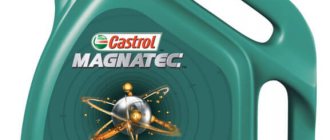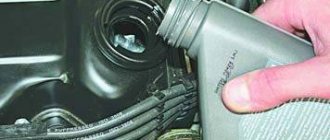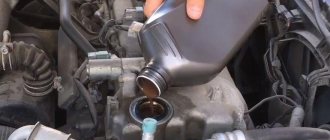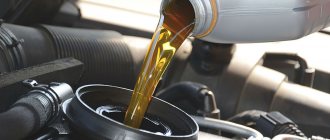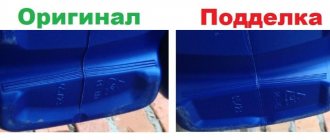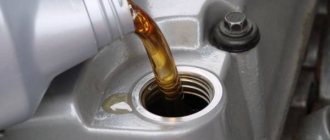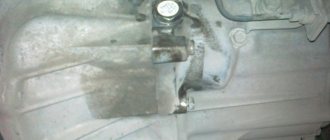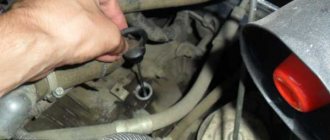How to check the oil level correctly
The procedure for checking the lubricant level is simple. It must be done daily before leaving the car.
Before checking the condition of the oil level in the engine, a number of technical conditions must be met:
- The car must be parked on a level surface. Tilts will lead to false readings.
- Free access to the measuring probe.
- The check is carried out on a warm engine.
The oil level is measured in the following order:
- The car engine warms up to 50 degrees.
- Wait 20 minutes to allow the lubricant to drain into the crankcase.
- Then you need to open the hood and pull out the dipstick.
- Insert it back into the car engine and wait a few seconds.
- You should pull out the dipstick and check the oil level.
The dipstick has maximum and minimum marks. The normal level is considered if the oil trace is between these marks.
Dipstick with marked marks
Determining measurement results
Channel No. 6 Garage shows the procedure for checking the oil level in a car.
How to add oil
You need to turn off the engine and leave the car on a flat horizontal area for several hours: for example, from evening to morning. During this time, the maximum volume of lubricating fluid will drain into the pan. After this, pull out the dipstick and look at the level. This needs to be done in two steps: first, take out the control rod and wipe it with a rag. Then lower it into the pan again and pull it out again: then the readings will be as accurate as possible. Further:
- add 100-200 ml of oil;
- wait at least 10-15 minutes for the engine fluid to drain into the pan;
- check the level by pulling out the dipstick;
- repeat the procedure if necessary.
How much oil to pour into the engine: opinions of car enthusiasts
- Does the actual volume coincide with the recommended one? “The ZL-DE engine requires 2.8 liters of oil to be filled according to the passport. It is possible that an empty engine will take that much after a rebuild. When replacing, I pour two and a half liters, since the waste is not completely drained. If you immediately fill in 2.8, then you already get the maximum. It’s better not to do that.”
- If you fill more
“The more oil you fill, the more difficult it is for the starter to crank the engine in cold weather. Therefore, I categorically do not recommend pouring to the maximum, and even more so a little from above (as some do, adding at random from replacement to replacement). It’s better to check often and refill as needed.” - If you do not fill the full volume
“I’m used to filling my car with engine oil to the maximum. One day I noticed that the engine compartment was covered in oil. It turned out that the front crankshaft oil seal had become too loose. It’s good that there was a reserve, otherwise the oil pump would have grabbed air and - hello, capital.”We recommend
“Flushing the engine before changing the oil: weighing the pros and cons” Read more
- The importance of measurements
“The calibration of a canister, even if it is branded, may be inaccurate. Therefore, we first measure the amount of oil, then we begin to pour it into the engine and check the remainder in order to fill the required volume. If there is nothing to measure with, then we pour a little at a time (100 ml each) and constantly check the level.” - How to fill
“A Japanese engine needs to be filled with 3 liters and started until the oil pressure light goes out. Then you look at the dipstick and, if it’s low, add another 0.2 liters. In summer you can fill to the maximum, in winter by 75% to the “max” mark.”
Startup problems
If the volume is significantly less than the recommended amount, it will take longer to reach top engine speed after the ignition is turned on. Ideally, it should reach these components in just a couple of seconds.
It is extremely important to regularly monitor the engine oil level. This is due to its possible consumption both due to wear of the cylinder-piston group, and during break-in or due to gasket or filter leakage. If the level drops below o, then you need to top up at least to the middle of the dipstick. As for overflow, it is not so terrible, although it is harmful. The excess will burn off and the level will adjust over time.
If you notice that the consumption is too high (more than 1.5 liters per 1,000 km), then you need to take action. Increased oil consumption may be due to too high engine speeds or wear of the cylinder-piston group and increased clearances in the combustion chamber. Because of this, oil will get there and burn along with the fuel-air mixture.
It is possible to determine how much oil to pour into the engine of a particular car experimentally. For example, you buy a 4- or 5-liter canister and a filter and start replacing it. Although it is much easier to open the service book and find out the exact volume, brand and viscosity of engine oil. The advice of an experienced motorist who has already done this work on his car several times can also help. In general, this is all that can be said about the amount of oil poured into the engine. It all depends on the type of engine and its size. For 1.6 you need approximately 3.5 liters. For 2.0 and 2.4 - about 4-5 liters.
We recommend: What kind of oil to pour into the engine
There are many motorists in Russia who are accustomed to relying solely on themselves when servicing their cars. This not only guarantees financial benefits (no need to spend money on the services of third-party specialists), but also ensures the proper quality of work.
One of the most popular ways for valiant servicemen to “con” car enthusiasts is still poor-quality replacement of engine oil: for some they don’t change it at all, for others they forget to change the filter, and for others they charge money for the additional volume of fluid that settles in the bins of the cunning master. Meanwhile, even a housewife can perform such a simple operation. To do this you need to have a couple of keys and really love your car. However, if you decide to perform this procedure yourself, it would be useful to find out how much oil you need to purchase for your engine. Today we are talking about four ways to determine how many liters need to be poured into the engine.
Can't you spoil the porridge with oil?
First of all, remember that the saying “you can’t spoil porridge with oil” does not work at all in the case of an internal combustion engine. Each individual motor is designed to work with a certain volume of lubricant. Of course, manufacturers provide a certain delta - maximum and minimum levels. These are the parameters that should be followed. If the engine oil level is too low, the engine will wear out much faster and cool poorly, and excessive volume will quickly damage the crankshaft seals and cause severe contamination of the intake tract. This is the same case when overfilling is just as dangerous as underfilling. Therefore, the volume to be filled must be approached responsibly.
To find out how much oil you need to purchase and pour into your engine, you can use any search engine on the Internet. However, the information obtained in this way may be incorrect and based only on speculation. In order not to make mistakes in such an important matter, we recommend using simple recommendations.
Methods for determining oil volume
1.
The easiest and most correct way is to find the owner's manual that came with your car from the factory. As a rule, every modern car has several Talmuds that tell about all the features of this model. Look in the contents and find the item “Vehicle Specifications”. In this section you will find the sub-heading “Lubrication System”. That's where the treasured numbers are located. For example, it will be said that the total volume of oil to be filled is 4.2 liters if the filter is replaced and 3.9 if it is not changed. You will also find information about what kind of oil needs to be filled - its type and viscosity.
Manufacturers usually recommend using oils produced under their own or a friendly brand. In fact, you can use absolutely any oil with similar parameters from any manufacturer - nothing bad will happen to the engine. It is only important that the specification of the lubricant meets the parameters specified by the motor manufacturer (the corresponding tolerances are directly on the canister label). Depending on the manufacturer, the sections of the instructions may vary, but the information you need is definitely there, you just need to take the time to find it.
2.
If for some reason the instructions have not been saved, you can use the official website of your car manufacturer. Often you can download the entire owner's manual or find basic information about the characteristics of your motor. Its specifications are easy to determine; just look at the registration certificate.
3.
Well, if you don’t find the information you need even there, use the help of specialized sites for selecting oil. By entering the make and model, year of manufacture into the appropriate fields and selecting the engine, you will receive many options for oils from different manufacturers. At the same time, you will be offered a package that will have enough oil to spare.
The Renault K7M 1.6 8V engine is used for installation in Renault Logan 1.6 8V, Renault Sandero 1.6 8V, Renault Clio 1.6 8V, Renault Symbol. Peculiarities.
The Renault K7M 1.6 engine is structurally no different from the one, the only difference is the volume increased to 1.6 liters. The increase in volume was achieved by increasing the radius of the crankshaft crank (other dimensions are the same); as a result, the piston stroke increased from 70 mm to 80.5 mm. The height of the cylinder block has increased, but all its geometric parameters are identical to the K7J. The Renault K7M and K7J engines have the same cylinder head and connecting rods. Engine life is 400 thousand km. Based on the K7M engine, a motor with a 16-valve cylinder head was created. This engine has more advanced characteristics and technologies.
We recommend: What is a car stabilizer strut: features, design, functions and what it is needed for
Methods for determining oil filling volume
Often the root cause of many engine breakdowns is an incorrect oil level, either too high or too low. This means that accurate data on the filling volume of engine oil in the engine for a particular car is necessary. There are several methods for determining the required amount of lubricant:
- The easiest way is to get information from your car's owner's manual . If you don’t have one, you can always download it from the official website of the machine manufacturer. The figure we need is contained in the “Lubrication System” section. The oil filling volume will be different depending on whether the filter is being replaced at the same time or not. In the same section you can find the viscosity and type of recommended lubricant.
- If you are unsuccessful in finding documentation for your car, you should turn to resources on the Internet that specialize in the topic of oil selection . Usually it contains a form where in separate lines you need to indicate the manufacturer and model of the car, engine type and year of manufacture. Next, the service will select the optimal types of oils from various brands, and also offer the most rational packaging. The last one should be considered when after filling a small amount of oil remains in reserve.
You need to remember the following nuance: the car owner's manual indicates the full volume of oil, that is, required to fill an empty engine. In a normal situation, when changing the oil without disassembling the engine, a certain amount of old lubricant remains in it (up to 0.5 l), so you need to add slightly less new lubricant than required according to the passport.
You can set the required oil filling volume using the following recommendations. Power units of domestic cars with a displacement of 1.8–2.4 liters require 3.5–4 liters of oil, while imported internal combustion engines of a similar volume require 4–4.3 liters.
How much is needed
When changing the lubricant, another question arises: how much oil is needed in the engine. If it rains as much as it did, as some drivers do, it can lead to irreparable consequences. For each motor there is a certain amount of lubricant, which is controlled by a special dipstick. Every car has an instruction manual that tells you how much oil needs to be poured into the engine; if there is none, you can buy it in a store or download it online.
If the car is equipped with an engine with a volume of 1.8 to 2.5 liters, then, as a rule, from three to three and a half liters of lubricant are filled. In order to create the required amount of liquid, you need to pour about three liters, and then control the volume of oil in the engine, guided by the marks on the dipstick.
3.5 liters are required for cars of a domestic manufacturer, foreign cars for the same engine will require 4.2 - 4.5 liters of lubricant.
What volume of oil fits into the container for motor lubricating fluid for a particular car can only be found out in a practical way.
Danger of excess oil in the engine
Exceeding the recommended volume is also unacceptable. The design of the engine assumes that the volume and shape of the engine sump does not allow the crankshaft counterweights to plunge into the oil bath and thus foam it.
Let's consider the consequences of such a situation. The foamed oil mixture loses its properties because the base oil and additives are not designed to work in this mode. All tests are carried out under conditions other than the crankshaft being used as a mixer. In addition, foam can rise quite high and end up in places where its presence is not intended. The result will be accelerated wear and premature engine failure.
You can indirectly track how much oil is poured into the engine by looking at the condition of the glow plugs. Filling even 10 mm above the “max” mark is fraught with oiling of the spark plugs and uneven engine operation.
The most obvious indicator will be the general clogging of the engine through gaskets and seals, which do not retain the additional volume of oil and gas-oil suspension. Leaks and fogging will leave the engine compartment in a dirty, sloppy state.
Let's summarize the dangers of oil overflow:
- deterioration of engine starting characteristics, especially in hot and cold weather;
- contamination and coking of engine cylinders;
- increased load on the oil pump and its rapid failure;
- accelerated wear of the catalytic converter and oxygen sensor in the exhaust system;
- increased exhaust smoke;
- the appearance of foamed oil reduces the pressure in the system and primarily damages the hydraulic valve compensators.
So, the answer to the question: how many liters of oil to pour into the engine will, of course, be the recommendation in the operating instructions. In general, experts believe that pouring more is not so critical; an insufficient level is much more dangerous. But it’s even better to avoid extremes and fill strictly according to the norm.
How to change the oil yourself?
The oil has its own permanent place under the hood, shaped like a canister and connected to the engine with hoses. When a spark is supplied to the combustible mixture, oil is pumped from the container into the engine crankcase, where it fills all the space, washes the moving pistons, cools the internal combustion engine, and flows heated into the sump, from where it returns again to the container, where it mixes with cold oil and cools. A kind of circulation of oily liquid occurs. It is because of this circulation that the volume of oil to be replaced in the engine exceeds the capacity of the car engine itself.
If the oil movement system is well-functioning, the seals and filters do not leak, then the oil volume remains unchanged for a long time. But sometimes leaks appear due to worn out seals, poorly connected hoses, or a loose drain hole, and the fluid level drops. Accordingly, the pressure drops, and you have to constantly top it up.
The crankcase has 2 holes - a drain, which is located in the bottom, and a filler, through which it is filled.
It is not recommended to perform any manipulations with the oil immediately after turning off the engine, because it will be very hot and you can get burned by it. Before draining the oil product from the crankcase, or performing repair and maintenance work, the engine must also cool down.
But still, to reduce viscosity and improve fluidity, it is desirable that the oil be tolerably warm. When the engine is cold after being idle, it is worth starting it for a short time.
It is better to change used oil on a lift or in a pit. Please note that on most new cars, especially foreign cars, the engine is protected from above by a casing. It must be removed before starting work. At the bottom, the metal casing protecting the oil pan is removed.
The oil filler cap is unscrewed from above. This is necessary so that a vacuum does not form in the crankcase, and the air penetrating into the container pushes out the drained liquid. Place a convenient container (for example, a small bucket) under the crankcase drain hole, and unscrew the drain hole cover. And while the waste oil product is drained, you can unscrew the oil filter. Keep in mind that a small amount of waste oily liquid will also leak out from under the filter; place some kind of container under it as well.
The oil will drain for 10-12 minutes. Take your time. Allow the waste fluid to drain completely. Then pour in about 0.5-1 liters of fresh oil, and let it flow through the system, washing away the remnants of the old one. When all the liquid has flowed out, screw on the drain cap, set the bucket aside, install the oil filter and pour new oil through the funnel, previously purchased at an auto parts store.
Important. If you change the oil filter, be sure to pour a little oil into it so that the engine does not experience oil starvation in the first seconds of operation. When installing the new filter in place, do not overtighten so as not to damage the rubber seal.
After you fill in the oil, replace the casings and check the level with a dipstick, start the engine for 5 minutes, let the lubricating fluid fill the entire volume. Then check the level again with the dipstick. If it is lower, top up and tighten the oil filler neck tightly. Pay attention to whether there are any leaks under the machine from the filter or drain hole.
We recommend: When should you change brake pads and what are the signs of wear?
Next, you will find out how much oil you need to fill in the engine of various models and brands of cars.
Oil change intervals
The car service manual necessarily contains an important figure - the frequency of engine lubrication changes, determined by mileage. For example, if the car is operated in gentle mode, mainly outside city streets, then it is acceptable to change the engine oil after 15,000 km. Driving in the urban cycle requires more frequent replacement - once every 9,000–11,000 km.
However, these are approximate data, because the condition of the oil is influenced by the following factors:
- The quality and type of fuel filled into the tank.
- Volume of the power unit.
- Type of previously filled oil and its condition.
- Number of operating hours of the motor.
- The serviceability of transport in general.
- Operating conditions of the machine and modes in which the engine operates.
Exposure to these factors changes the condition of the engine oil. If its performance properties decrease, then wear of the power unit parts occurs very quickly. In this situation, it will no longer be possible to determine whether the oil needs immediate replacement using improvised means; an analysis must be done in a specialized laboratory.
However, there are methods for determining when to replace the lubricant without involving expensive laboratory tests. Two such methods are widely used: based on fuel consumption and engine hours.
We recommend
“Where can you change the oil, and how best to do it” Read more
- Mandatory oil changes calculated by engine hours
As initial figures, you need to know the average speed of the car in the urban cycle and the manufacturer's requirements for servicing the internal combustion engine. For example, in the city a car moves at an average speed of 40 km/h, and the factory recommends changing the lubricant every 15,000 km.
To get engine hours, divide the distance traveled by the average speed. In our example it looks like this: 15000 / 40 = 375 engine hours. From this formula it follows that every 375 operating hours it is necessary to replace the lubricating fluid in the engine.
The replacement interval for oils of various types in engine hours is given in the table contained in the international API standard.
| Type of oil solution | Operating hours |
| Mineral | 130–150 |
| Synthetic API SJ / SHAPI SL / SMPolyalphaolefinsEsters | 230–250 / 320–350 / 370–400 / 430–450 |
| Semi-synthetic | 230–250 |
Let's consider an example when SL/SM oil was poured into the engine, the service life of which is 330 operating hours. To calculate the mileage, you need to multiply the average speed of 40 km/h by the engine life of 330 engine hours. In total, it turns out that you don’t have to change the oil until the car has driven 13,200 km.
- Replacement interval based on fuel consumption readings
Calculations are based on the rated fuel consumption per 100 km and the actual value. Let’s say the car’s characteristics indicate that fuel consumption averages 9 liters per 100 km. At the same time, what was measured in practice turned out to be 11 liters. The manufacturer's requirements are to change the oil according to the regulations once every 15,000 km.
It is required to calculate fuel costs for 15,000 km for passport data and real ones. Factory parameters: 15000 x 9 / 100 = 1350 liters, actual measurements: 15000 x 11 / 100 = 1650 liters.
Now, adjusted for actual consumption, we use the same proportion to calculate the mileage after which an oil change is necessary: 1350 x 15,000 / 1650 = 12,270 km.
This method is universal; it can be used to calculate the lubricant change interval for any vehicle with an internal combustion engine. The main thing is not to forget to record the vehicle mileage data at the time of the next replacement.
Too high oil level: good or bad?
An option is being considered when the lubricant level in the internal combustion engine is higher than on the dipstick. The reason is an overflow of oils associated with the inattention of the car owner or insufficient warming up of the engine before replacement. Some drivers believe that the higher the oil level in a car engine, the better the engine will pull, but this is not true.
An increased level of lubrication can cause great harm to the car, because the oil pressure in the engine increases, which will lead to damage to the unit. Gaskets and seals may be damaged. Therefore, if the engine oil level is too high, do not use the vehicle.
What happens if you don't add oil to the engine?
A low level will negatively affect the functioning of the motor. For normal engine operation, the oil pump must provide the required pressure. If there is insufficient liquid level in the pan, then, accordingly, the pump will not cope with its work and pressure drops and oil starvation will appear.
The most loaded part of the engine is the crankshaft. It is made of carbide steel and ground at the point of contact with the plain bearings. Inserts, on the contrary, are made of soft metal and are more susceptible to wear. An oil wedge is created between the liner and the crankshaft journal, lubricant is supplied to it through a special oil channel in the crankshaft body. A decrease in the thickness of the oil film or its absence leads to dry friction and accelerated wear of mating parts.
We recommend
“How to check engine oil: rules and recommendations” Read more
Low pressure in the lubrication system for a long time will lead to fatal consequences. The soft material of the liner will begin to soften due to dry friction and move to the edges of the journal, then it will begin to melt and stick to the crankshaft, after which the liners will rotate and a major engine overhaul will be required. It is better to fill the oil to the required level in a timely manner.
After stopping the engine, the parts will cool down, but the deformed liners will not return to their original shape. Steel parts will suffer less damage, but will acquire characteristic stains of overheated metal.
If the liners still do not turn, then the shift of the metal from the center to the edges will lead to an increase in the gaps in the friction pairs and to a metallic knock during engine operation. It is especially audible when the pistons are moving to TDC. This sound indicates that it is too late to add oil and you need to prepare to disassemble the engine.
In addition to the crankshaft and main bearings, connecting rods also suffer. Their lower head overheats, and the metal loses strength if the lubricant is filled below normal. The bolts securing the connecting rod cover are also affected. As a result, the connecting rod may break or the bolts may break. In any case, the consequences will be the most dire. A piece of connecting rod, falling into the space between the cylinder wall and the rotating crankshaft, pierces the wall of the cylinder block right through. The severed part falls into the sump and is pressed by the crankshaft counterweight against the cylinder block sump, puncturing or deforming the crankcase.
Even if there are no devastating consequences, the results of low oil levels will still be unpleasant. A decrease in pressure in the oil line will lead to poor spraying of lubricant onto the cylinder walls and the entry of destruction products (metal particles) into the working chamber. As a result, scoring marks form on the cylinder walls.
Another sign of insufficient levels is the so-called “oil mist”. It is created by rotating engine parts if lubricant is filled below normal. Oil droplets are broken into tiny particles, forming a suspension in the internal cavities. All parts are covered with a layer of oil and have a dirty appearance. This is especially visible at the bottom of the drive. If you notice such symptoms, get ready to add oil.
Determining the displacement of lubricating fluid without instructions for the car
This can be done during the next oil change. It is worth noting that if you bought a car secondhand, especially from a stranger, it is advisable to change the engine fluid immediately: it is unlikely that the former car owner will “splurge” on a new lubricant before selling it. Drain the old oil and transfer it to a canister with a known volume. It is better to free the crankcase from old lubricant in the evening, so that the maximum amount of it can be drained overnight. Approximately 100 ml must be added to the resulting volume - the remainder that cannot be drained. This way you will find out the standard amount of oil in the engine without the car's instructions.
Types of crankcases
Crankcases can be “wet” or “dry”.
wet , because in them the oil spontaneously drains along the inner walls into the sump.
Dry sumps are used on some SUVs and sports cars. In this option, the oil is collected in a container that is installed separately, next to the engine or on the outer surface of the crankcase. This is done so that the crankcase provides high-quality lubrication even when taking sharp, high-speed turns and when driving on inclined surfaces.
Wet sump
Dry sump
What happens if I pour too much?
On the other hand, overfilling your car can be as much of a problem as too little lube for your engine.
The crankshaft, which is responsible for powering the pistons in your engine, often lies just above the oil reservoir. Typically the pump pulls oil out of the sump so it can do its job.
However, if levels are high enough to come into contact with a fast moving crankshaft, the oil becomes prone to foaming. This airy, bubbling mess is difficult for the pump to properly capture and distribute, meaning the engine won't receive the even, thin layer of lubricant it needs to perform at its best.
The need for replacement according to engine hours
The initial data is the stable average speed of the vehicle in the city and the manufacturer's recommendations for changing the lubricant. Let's say the speed in the city is 40 km/h, and the factory recommendations for replacement are 15,000 km.
To calculate engine hours, you need to divide the distance by the speed limit. In this situation, 15000/40=375 m/h. The obtained value means that after 375 operating hours of the power plant it is necessary to change the oil.
The API international standard has developed a summary table for replacing oils, depending on their type and service life.
| Type of oil solution | Operating hours |
| Mineral | 130-150 |
| SyntheticARI SJ/SHAPI SL/SMPolyalphaolefinsEsters | 230-250320-350370-400430-450 |
| Semi-synthetic | 230-250 |
Let’s assume that an SL/SM oil solution with a working life of 330 hours was poured into the vehicle engine. To determine mileage, you need to multiply 330 m/h by the average traffic of 40 km/h. As a result, the mileage until the next lubricant change will be 13,200 km.
Engine characteristics Renault K7M 1.6 8V Logan, Sandero, Simbol
| Parameter | Meaning |
| Configuration | L |
| Number of cylinders | 4 |
| Volume, l | 1,598 |
| Cylinder diameter, mm | 79,5 |
| Piston stroke, mm | 80,5 |
| Compression ratio | 9,5 |
| Number of valves per cylinder | 2 (1-inlet; 1-outlet) |
| Gas distribution mechanism | SOHC |
| Cylinder operating order | 1-3-4-2 |
| Rated engine power / at engine speed | 61 kW - (83 hp) / 5500 rpm |
| Maximum torque/at engine speed | 128 N m / 3000 rpm |
| Supply system | distributed fuel injection MPI |
| Recommended minimum octane number of gasoline | 92 |
| Environmental standards | Euro 4 |
| Weight, kg | — |
In order to find out how much oil to pour into the engine, you can read the instructions, which are available for each car on the Internet or in any car store. Only after you have found out what kind of oil needs to be poured into the engine, can you purchase it. You should also find out what kind of oil was filled before, and, based on this data, buy a new one. Do not mix different types of oils.


